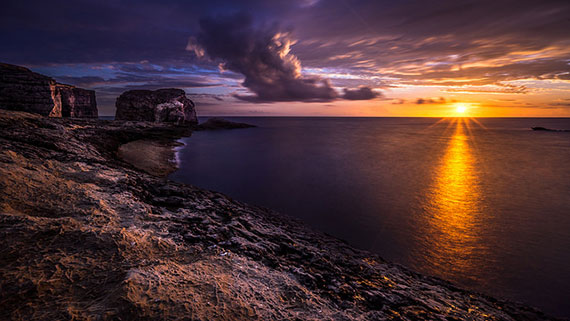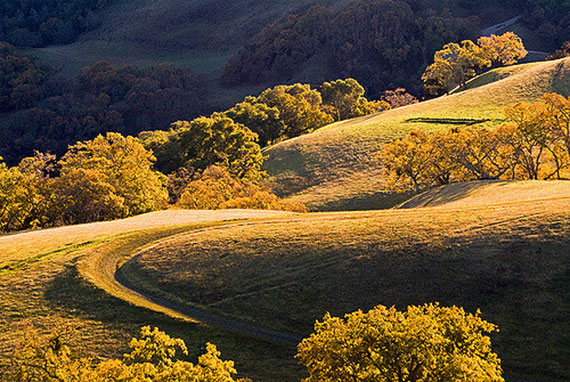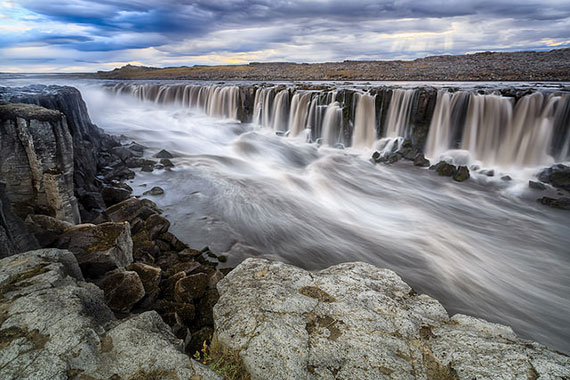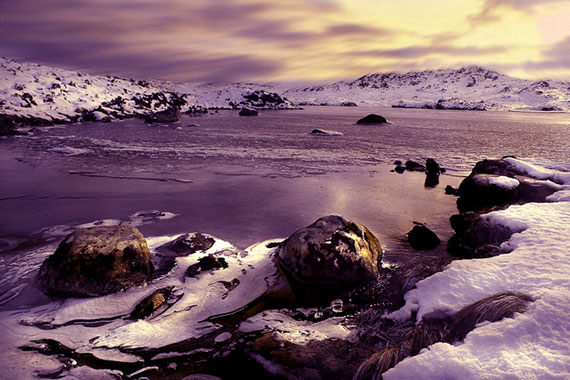Landscape photography is a great adventure, but also a challenging endeavor for any photographer. Here are ten tips for both beginner and advanced photographers working on improving their landscapes.
10 Tips and Tricks for the Beginner
1. Shoot close to sunrise and sunset to achieve more balanced exposures. Shooting during the harsh daylight produces very contrasty light, and it’s difficult to capture details in both the shadow and highlight areas. If there’s one thing you take away from this guide it should be this!

Photo by Giuseppe Milo; ISO 50, f/22.0, 30-second exposure.
2. Compose an image to exclude more and include less. Remove any element that doesn’t add to the image. Simplicity is often the key!
3. Shoot in RAW format for maximum quality if you’ll be doing any post-processing. This is really a big deal!
4. Switch to manual focus, focus one-third of the way into a scene, and do not use the smallest aperture of the lens (e.g. f/22). Instead use at least 2–3 stops up from the smallest opening in order to achieve sharper images.
5. Use a remote cable release or the self timer in addition to a tripod to increase sharpness. This makes such a big different especially when long exposures are required! To increase sharpness even further, engage the camera’s mirror lock-up feature if it comes with one.
6. Use Live View in conjunction with full magnification to manually focus. Thank God for Live View!
7. Shoot waterfalls under overcast conditions. This allows the shutter to remain open for longer in order to achieve that nice silky water movement that you see so often and wonder how it is done! Alternatively, shoot in shutter priority mode (Tv) and dial in a shutter speed of at least 1/15 seconds, or better still use an ND filter to achieve the same effect.
8. To achieve turquoise blue water, shoot when the sun is directly positioned overhead (i.e., around midday).

Photo by Sathish J; ISO 400, f/6.3, 1/500-second exposure.
9. Compose a scene with naturally occurring lead-in lines within the foreground and use them to guide the viewer to the main subject. An interesting but not dominant foreground also gives the image depth.
10. Shoot at the lowest possible ISO (e.g., 100) to produce the best possible quality images. Using a tripod will be a big advantage!
10 Tips and Tricks for the More Advanced
1. Expose to the right. What does this mean? Using a digital camera’s histogram, ensure that the range of tones are pushed as far as they can go to the right-hand side of the histogram graph without touching the right side. Doing this will increase the amount of information recorded in the image and therefore quality!
2. Don’t just rely on a single capture to create an image. Take two or three different exposures and blend them together later in Photoshop by combining the best elements of each. Yep—this is a big secret from the pros!
3. Wherever possible, try to avoid using filters as filters typically soften images and therefore reduce sharpness. As an example, instead of using ND graduated filters, capture one image exposed for the foreground and another for the sky and then blend them in Photoshop. If you need to use a filter to achieve an effect (e.g., using an ND filter to achieve a silky water effect) then take a separate image without the filter and another with the filter applied and blend in those areas containing all of the juicy detail that you’re after.

Photo by greenzowie
4. Always do your homework on a location in preparation for a shoot and if possible ensure that you have visited the location to pre-visualise the optimum composition. Pre-visualise also how the scene would appear under the optimum lighting conditions and then return well in advance of the optimum lighting arriving. Use the harsh daylight hours to perform your homework on a location.
5. Take multiple captures of water movement until the optimum water movement has been captured. If the water movement is too slow, increase the speed of the ISO and vice versa. Adjusting the ISO ensures that not only the exposure is left in tact but also the depth of field.
6. Capture panoramic images by stitching multiple image captures together. Ensure that the camera is set to manual shooting mode, manual white balance, manual focus, overlap each image segment by approximately 30 percent, and ensure the tripod is perfectly level. Positioning the camera in a portrait orientation will also give you more scope when it comes to cropping.
7. In tricky lighting conditions, experiment using different metering modes rather than always rely on the Evaluative/Matrix metering mode to determine the correct exposure. For example, use the Center Weighted or Spot metering mode.
8. To yield optimum depth of field, use hyperfocal focusing by identifying the hyperfocal distance using both the lens focal length and aperture and then focusing on the hyperfocal distance.
9. To further improve depth of field and sharpness and get images appearing tact sharp from the near foreground to the distant background, capture two separate images with the first focused on an element in the foreground and the second on an element in the background. Then blend the two images together later in Photoshop. Photoshop makes this easy by automatically selecting the sharpest sections of both images and combining them!

Photo by grayeme; ISO 100, f/16.0, 1/60-second exposure.
10. Use The Photographer’s Ephemeris to research locations to shoot in advance and easily identify sunrise and sunset times at any time of the year for a specific location. This tool is a must have, and best of all it’s completely free!
About the Author
Ricardo Da Cunha is an Australian landscape photographer. He is an experienced trainer and offers private one-on-one day courses in either half/day (4 hour) or full day (8 hour) sessions. Aimed for beginners and amateurs, a complete full day private course consists of the first 4 hours of tuition out in the field in image capture and the other 4 hours is spent behind the computer in post image capture processing.
Go to full article: 10 Landscape Photography Tips: Beginner and Advanced
What are your thoughts on this article? Join the discussion on Facebook
PictureCorrect subscribers can also learn more today with our #1 bestseller: The Photography Tutorial eBook
The post 10 Landscape Photography Tips: Beginner and Advanced appeared first on PictureCorrect.
from PictureCorrect https://ift.tt/2QgBoqx
via IFTTT






0 kommenttia:
Lähetä kommentti